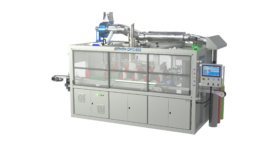DPC403
Plasma coater for bottles
What is plasma coating?
PECVD is short for ‘plasma enhanced chemical vapour deposition’. It uses electrical discharge (in a low vacuum pressure condition) to decompose a gas. By doing so, it creates a thin coating layer on the inside wall of the product.
Besides, plasma coating is an environmentally friendly way to create fully recyclable coated products. They can have different physical and/or chemical properties. These depend on the material and the plasma gas used.
You can obtain different properties:
- modify the surface tension for better sliding, adhesion, wettability
- improve the barrier in different applications: migration, permeation…
Plasma coating, the environmentally friendly approach!
As you may know, new legislation is on its way. It will require ambitious recycling of packaging material.
That is challenging for multilayers, because they provide good barrier properties, but are non-recyclable because of their different, inseparable layers.
Our plasma coater can create better barrier properties than multilayers. But you may consider it as a monolayer packaging.
It is easy to grind the coated material and recycle it, together with non-coated materials:
- The percentage of our coating is negligible to that of the plastic packaging: 60 to 150 nanometers.
- The coating will be largely removed during the washing process.
- Coated bottles will not reach a market penetration much higher than 10 %. As a result, this rules out a change in flake quality in the recycling plants.
We only use environmentally friendly gases for plasma coating.
Furthermore, the gases are largely consumed during the process, reducing the exhaust to a minimum. In addition, an active carbon filter can easily capture the remainder of the gases, should local legislation require this.
The machine
The DPC403 can coat bottles from 0.1L up to 2L. The machine inserts the products into a vacuum chamber, after having vacuumized both.
This plasma coater for bottles can use 2 technologies:
- Carbon deposition on PET containers. This results in an improved O2 ( >30x) barrier, CO2 ( >7x) and H20 ( >2x).
- Carbon Fluor deposition. This results in a ‘fluorinated’ container without actually using any Fluor.
This is a quadruple vacuum chamber (=4) machine. It can treat around 500-700 bottles per hour (HDPE) or 750-1400 bottles per hour (PET), depending on the process and volume.
However, these speeds are indicative, so please use our calculation tool to simulate the exact speed, power and gas consumption.
This plasma coater for bottles uses proprietary technology. Therefore, we only disclose limited info on our website. So please contact us for more information.
We can develop specific barrier processes depending on your needs.
ADVANTAGES
- Weight reduction of the bottle
- We can adjust the barrier to your needs
- 100 % recyclable
- Can treat PET & HDPE containers
- On PET: Improved Oxygen barrier
- On HDPE: Improved Solvent barrier
Please download our Technology brochure for a full overview.
OTHER VERSIONS
Plasma coater for containers: DPC123, DPC223, DPC413, DPC613
L Ring plasma coater for drums: DPC133

